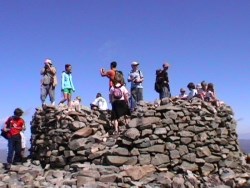Keep moving
It might feel natural to completely stop for a few days and not move, but this isnít the best thing to do after a big walk and will mean you are out of action for quite a while. With complete rest your muscles will recover in 3 to 7 days, but some gentle exercise to keep you moving is recommended for a quicker recovery - so a low level walk on the flat, or exploring some of the scenic sites is a good way to start the healing process.
Donít push yourself until your muscles have healed and are no longer painful. You need to give your body time to recover. Pain is natureís way of telling us to take things easy - ignoring this important signal could result in more serious damage.
If your pain is particularly severe, or persists after 7 days then please consult your doctor.
Prevention rather than cure
Unless you climb mountains regularly some muscle pain will be inevitable after a walk up to the summit of the UKís highest peaks. Prevention is always better than cure, so you can lessen the aftereffects of a climb by preparing as best you can for your endeavours.

Join us on
Please visit the Sitemap to see the full range of information on this site
MountainWalk.co.uk is produced by Trish Haill Associates Copyright
How to Recover from your Mountain Walk

You many have spent a lot of time making sure you are in the peak of fitness for your mountain walk, or you might just have walked up Snowdon or Ben Nevis on a whim to see how far you could get. And then found, when the summit was in site that you just kept going!
The sense of achievement on reaching the summit is immense - but may well have taken a toll on your muscles!
Even if you have done everything in your power to prepare for your walk, youíre almost certain to find that youíve put quite a strain on your muscles and will feel the aches and pains afterwards. It may not even come on immediately - you may find that you get a condition known as Delayed Onset Muscle Soreness (DMOS). This is caused by microscopic tearing of muscle fibres and typically starts 24 hours or so after strenuous exertion that your body isnít used to. Itís very common, and doesnít mean youíve done any lasting damage. The pains reach their peak after about 48 hours, and then start to subside.
So hereís some tips to look after yourself after your mountain walk to ease your pains and lesson the effects of DMOS. The good news is that after the pain has subsided, your muscles will be stronger and youíll be fitter to tackle your next peak!
So hereís some tips to look after yourself after your mountain walk to ease your pains and lesson the effects of DMOS. The good news is that after the pain has subsided, your muscles will be stronger and youíll be fitter to tackle your next peak!
After your walk
The healing process starts as you take those last few steps and finish your walk. Before you collapse try a few gentle stretching exercises particularly if your muscles feel tight after youíve descended the mountain.
It is very important that you make sure you drink lots of water and fluids, which will help aid your recovery and replace the fluid lost during our walk. Your muscles will be most receptive to carbohydrates in the first two hours of finishing your walk, so if you can, eat a good meal containing carbohydrates and a little protein to help with repair. You will have expended a lot of your energy stores on your climb which will need to be replaced.
Take a Shower, not a Bath
Although it might seem very tempting, donít soak in a hot bath. Hot water will dilate your blood vessels and will make your muscles swell. If theyíre already swollen, this really woníthelp to ease your pain. Take a shower instead, and run it hot for a couple of minutes, and then alternate with 30 seconds of cold water, repeating this process a few times.
Throbbing Muscles
If your muscles are throbbing and sore, compression socks can help maximise the circulation in your legs, which can improve blood flow and muscle recovery. Compression socks are best put on 2 to 3 hours after you complete your walk.
Many people recommend a good massage with long strokes to help stimulate circulation. There are many aids, such as massage rollers, which you can buy that will help make massage easier (particularly if youíre doing it yourself).
Muscle recovery gels may also come in handy if youíre particularly sore, as well as taking an anti-inflammatory such as ibuprofen.
Sleep is Good
On the evening after the mountain walk, take steps to make sure that you sleep well. Switch off any lights, as well as standby lights, unplug the phone, and switch off the alarm clock and rest. Keep a glass of water by the bed side so you donít get dehydrated. Sleep is natureís aid to healing as during sleep your muscle tissues will grow and repair.
